|
|
This week, I’ve been working on processing the World Series of Poker results to generate some stats for discussion on a well known poker web site.
All the information is out there if you want to try this at home. You can get the full player lists in a PDF file for every event, and the list of winners is on a web page.
The challenge is that the player details are prone to mysteriously change from one list to the other.
For example, Michael “The Grinder” Mizrachi appears to have moved from Miramar to Miami in between buying his ticket and picking up a $1.5 million second place prize. A whole bunch of players also seemed to suddenly move to Las Vegas from all over the country as soon as they picked up their cheque.
I expect their occupation also changed overnight, to “professional poker player” (or “adult movie star”) in anticipation of an inevitable Full Tilt (or Ultimate Bet) sponsorship deal.
Even having to contend with these delusions of celebrity, I don’t think I’ve done a bad job of getting some talking points out of the data. A handful of players will have their wins recorded against someone else with the same name (but that happens to the best of us!) but mostly it’s a decent set of figures. I’ll link to the full thing once it’s live.
But for now, the item that caught my eye the most is actually one where the player’s names don’t even matter, so I’m pretty confident in these stats.
In aggregating the entry fees and winning, and then calculating a return on investment by country, we can see that players from the USA are, as a whole – gasp – long term losers.

It’s not really any surprise to see a loss here. Americans make up about 80% of the field and it’s a negative expectation game. There’s juice of 6%-10% taken from every buy-in, no prize pool guarantees, no sponsor money added. So, having the largest number of results available by far, you’d expect to see Team USA’s ROI tending towards this range sooner than any other country.
But it’s much worse than that. After 16 events, they’re down a cool five million (about $350 per entry), with a combined ROI of nearly 20% in the wrong direction.
Across all players, the ROI comes in at roughly -9% (it’s skewed towards the top end of the range by the massive field sizes in the cheaper events, which are taxed more heavily).
Here’s the soundbite: Americans lose twice as much money at poker than the global average.
Sample size, yada yada yada. Yes, possibly – but most of these events don’t have seven-figure prizes to quickly turn around that $5m national deficit.
I just thought it was an interesting number, and I’ll be watching it to see if the trend continues.
I’m still not sure if this email I had tonight is genuine.
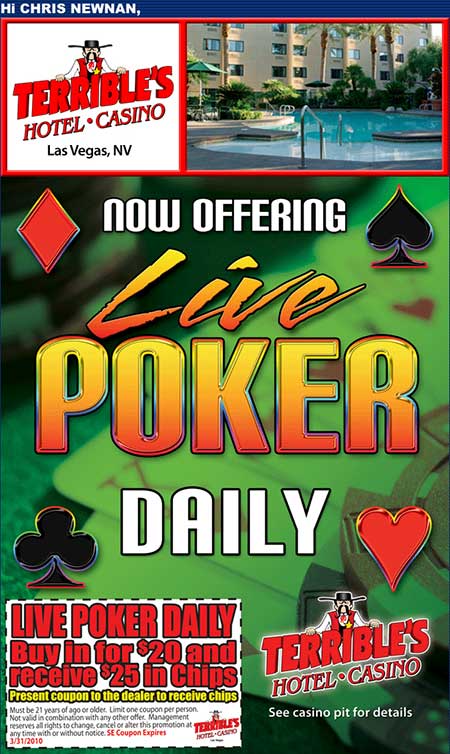
For a start, if Terrible’s really has live poker, I’m quite disappointed that this mailer didn’t come with a picture of Mr Terrible wearing sunglasses and an iPod. They usually make an effort to dress him up whenever possible, and this would be a perfect opportunity.
But let’s assume this is for real (they routinely spell my name wrong on emails this way, so that goes some way to verifying the authenticity).
How on earth did they find space to put in at least one poker table? It’s pretty cozy in there already.
The sportsbook is so small it has about half a dozen seats and the pit is perfectly crammed into the middle of the action so that if you want to play Wheel of Fortune and roulette at the same time, I’m pretty sure you’d be able to. And if there happens to be a line for the cashier (particularly likely on paycheck day) snaking through a tightly arranged grid of video poker machines at least gives you something to lean on while you wait.
They’ve recently moved the player’s club out of the broom cupboard next to the gift shop into a kiosk on the casino floor, but I can’t see that space being any use for poker. It’s not much larger than six feet square.
The mailer says “see casino pit for details”, not “see poker room”. They clearly don’t have any pretensions of being the Bellagio (thank goodness). It might just be one table. And you might have to ask for directions.
There’s just nowhere I can think that even one table could go without needing to get rid of either slot machines, table games or space in the bingo hall, and I can’t see any of those happening for a game that (according to the coupon on this mailing) has a $20 minimum buy in.
That would make it one of only two such recession-busting poker games in Las Vegas (the other is a single $1 blind no-limit Hold’em game at Bill’s). I can’t wait to see what games are on offer, and what kind of clientele it attracts.
I can’t find any other details about this. Nothing on Terrible’s own web site, or any of the usual suspect Las Vegas poker blogs. I might actually be the first to break this massive poker news in the whole of the “blogosphere”.
Oh how I hate that word.
However, to be fair, I’d be surprised if any other bloggers were on Terrible’s mailing list, let alone had ever stopped by for a 99c coffee and Krispy Kreme special.
Here’s an amazing statistic, coming from the insightful TV commentary leading up to kick off in yesterday’s Super Bowl.
It came after the large no-cash-value metal disc they loosely called a “coin” was flipped into the air and landed on the side they’d decided that today they would refer to as “heads”. I think that side had a helmet on it, so it was close enough.
“The past 13 years the NFC team has won the toss. The odds of one team winning 13 straight are about eighty-one hundred to one”.
Obviously, this kind of revelation is the reason commentators don’t STFU during the pre-match shenanigans and wait for the actual game to start.
In fact, the number he was looking for is closer to eighty-two hundred. Two to the power of thirteen is 8,192, which would give odds (assuming a fair fake coin) of 8,191-1.
The number’s right, but it’s not quite the right context. Indeed, across a series of Super Bowls, the odds of the team from one particular chosen conference to win 13 coin flips is as above, but the probability of one team winning 13 straight is lower.
If we don’t care who wins the first toss (after all, someone has to win it) then whoever does only needs to guess another 12 correctly to make a streak of 13. The odds of that happening are 4095-1.
Still a fairly unlikely occurrence, but it’s half the first number – and I’m sure they’d still have mentioned it if was the AFC team who’d got there.
It would be just as noteworthy – in fact, probably more so – if there was a streak of 13 straight heads or 13 straight tails. The odds of any one of the four streaks I’ve mentioned so far happening brings the price down to a heavily discounted 2047-1.
I began wondering, with all the stats that are thrown about during a typical NFL game, whether a game ever passes that something doesn’t show up that looks vaguely remarkable.
This coin toss streak actually only considers consecutive Super Bowls. It’s much easier to find wonderful patterns if you consider consecutive playoff games, or Monday evening games, or games played in domes, or in the rain, on the West Coast where at least one team is wearing blue. And they do look for this kind of meaningless correlation. All the time.
But in this case it didn’t need any such fudging. I’ve tried to discount it as much as I can, but it’s still a pretty terrific streak of coin flips coming down in the same arbitrary (yet definitely consistent) direction.
It’s one to remember the next time you hear someone complaining about a “sick” (see my air quotes there?) losing streak when playing online poker. Maybe they lost five or six 50/50 races in a row.
They’ll probably try to convince you this never happens in real life. Guess what… it actually does.
For what it’s worth, if you’d bet a dollar on the NFC winning the coin toss in 1998 and parlayed the winnings onto the same bet for the past 13 years at the typical bookmakers odds of 10-11, you’d be in for a whopping payout of $4474.51.
Not too shabby – but that equates to juice of more than 45% when you compare it to the true odds payout of $8192!
Yesterday, quite randomly, I found myself at the London Affiliate Conference.
You’d never know from the modest name, but this event is an expo specifically for affiliates of online gambling sites.
You know what? Other affiliate programs are available.
I wasn’t there for a conference, or as an affiliate – just for a meeting with someone who happened to be in the country because of it.
All the big names were there, which meant I was happy enough wandering around and gawping for a while. These things are usually pretty fun for about twenty minutes, after which they get really annoying. Fortunately I didn’t have to wait too long before my meeting.
I wandered round admiring the usual collection of free giveaway tat. Plenty of pens, t-shirts, calendars… that kind of stuff. The chocolate dice were particularly appealing, although I couldn’t help wondering whether the stand giving away branded cigarette lighters was exhibiting in the wrong decade.
And then I noticed this.
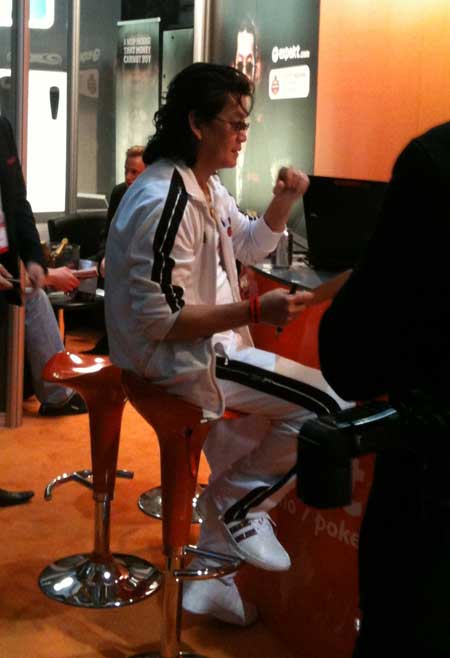
Scotty Nguyen, baby.
There are not many well known poker players that I would stop walking to take a photo of, but Scotty is the man, baby.
But wait, round the corner there was more:

At first I thought this was a looky likey… any dude in a hat could be pretty convincing. But it is your actual Texas Dolly, Doyle Brunson.
The godfather of poker, making a personal appearance because his online poker room has gone down the pan and they’re pushing a casino instead.
Quite a star studded line up for an event that I still haven’t really worked out why it exists.
After all, when your online business does online marketing for an online casino, what is the actual benefit of getting some face time – except to be able to pick up the odd Blue Square stress ball, or something.
You just make a web site that links to another web site and get people to read it, right? And if banner A makes you more money than banner B, you run banner A. You don’t run banner B because a pretty girl who was employed by them – probably just for the day – gave you a free umbrella.
It was only after I heard that one of the people I’d gone to meet – a gaming writer who relies on affiliate commissions to eat – had already interviewed Brunson that it dawned upon me: I was probably the only blogger there who had to sneak around with a camera phone to get pictures of these guys.
But along with that realisation came a reminder that I don’t write this rubbish for anyone other than myself. That’s pretty obvious from the fact I haven’t even bothered trying to put a banner ad on the site in three years. But I’ve come to realise what a world of difference there is between writing for fun versus writing for a living.
Not that there’s anything wrong with that (I’ve been paid to write before – albeit on a small scale, meaning I had plenty of freedom to choose the subject – and would do so again if the right gig came along) but it’s not what this blog is and I quite like it that way.
So to those of you that do actually bother to read this now and again and humour me when I talk crap or rant about things that aren’t really that important, I thank you.
As a side effect of planning forward for my next trip to Las Vegas, I’ve actually found myself staring at a summary of my entire live poker career so far.
As I’d decided to start using the iPhone app Poker Journal to record all my sessions from now on, it made sense to try to import all my old data into the same application before I got started.
That way I’d already have some lovely graphs to look at.
Although it’s not a documented feature of Poker Journal, it’s possible to use the backup and restore facility to import data from another source. In my case, I had a master spreadsheet that I’d built up over the past few years from all the mobile phone spreadsheets I’d been keeping on my travels.
To be honest, that spreadsheet didn’t do much. I’d set it to calculate a total profit/loss and done some (frankly) bodgetastic jiggery-pokery to give totals per trip and to add up limit hold’em and no-limit hold’em profit and loss separately. With a bit of effort I managed to get a graph out of it once.
I’d been in contact with the developer, Michael Golden, who had already drafted a document that explained the data format he used and because my spreadsheet was so simple it wasn’t too much of a problem to convert it. If anyone is in a similar situation, the script I wrote to process my own data might be of some use to you. Leave me a message.
So, what does this wonderful little app do? Let’s start with what matters – a graph, of course!
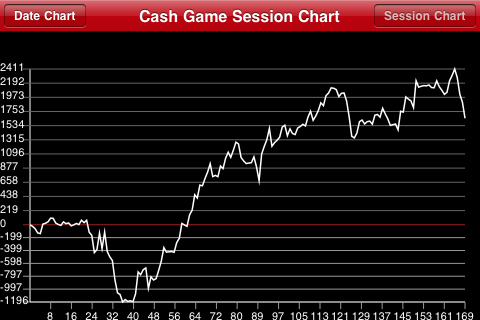
This is my cash game history for every session I’ve played in Las Vegas since 2006. I was a relative latecomer to The Cash. Thinking back, I probably I played a couple of sessions of $2/$4 in the summer of 2005 (my first month-long Vegas expedition, pre-blog) but not enough to make a difference.
I definitely didn’t touch no-limit hold’em until Summer 2006, and even then it was only briefly, scared away after the first attempt by the nine rocks I found myself surrounded by at Sunset Station. In retrospect, this was horrible game selection (based only upon which casino was close to where I was staying at the time) which probably set me back more than I realised.
You’ll see from the graph that after the minimal variance of $2/$4 limit hold’em, it took me a little while to find my feet with no-limit, and I had a 6 buy-in downswing (I almost always buy in for $200) before the climb back started.
Poker Journal does a bit more than draw pretty graphs too. There’s plenty of fascinating statistics. The ones below are filtered just for no-limit hold’em:
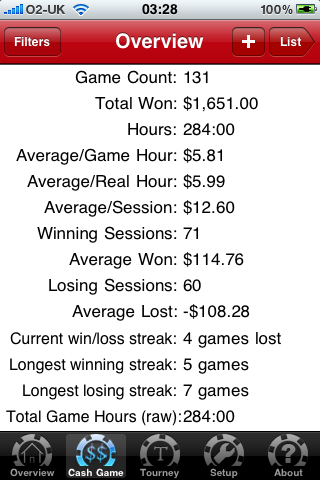
Hardly an hourly rate I can “go pro” with, but it’s in the black at least.
If I switch to “glass half full mode” the 71-60 winning record isn’t awful – and in reality, winning more sessions than you lose isn’t even important. What matters is winning more actual money the times you win than you lose the times you get sucked out on by some idiot douchebag who loves playing queen-three.
Not a bad beat story, I just made up a garbage hand at random. I promise.
With that 11 game differential, I managed to turn a profit of just over 8 buy-ins, which is a fairly reassuring way to look at it.
If only I could have “average luck”, surely that number would go up, right? …
But is 284 hours enough to draw any reliable conclusions from? No, not really.
My career graph currently ends on a bit of a downer – which reflects how my poker results went towards the end of the summer trip. Suddenly, I just stopped being able to win pots.
Whether I ran particularly badly or if it’s just variance, who knows. Maybe I am a $6/hr player (or worse) and it was about time for this to happen. I knew everything had turned to shit at the time and there wasn’t much I could do except to keep turning up and hope to catch a break before I had to catch a plane. I never did.
Boy am I ready for a re-match. Three days to go… 🙂
At the Luxor, playing in a $1/$2 no limit, I have a pair and I’m one of 6 players limping in to the pot.
The flop comes low – 854 – and all different suits. I quite like my overpair so after the big blind bets $5 I raise it to $15. The button calls my raise cold but the original bettor gets out of the way.
The cold call scares me a bit, and the turn card scares me a bit more: it’s a 6. There’s still no flush possible, but if the other guy has a 7 for a straight, I can’t win. If he already made two pair or a set, I’m in bad shape. I don’t see many hands that I’m beating liking this board any more, so I check but I still call a bet of $20.
The river was another 8, so there’s still no flush possible but now even more ways I can lose the pot. I just check and call again, relieved that his bet was only $40 into a pot of more than $80.
"I have an eight", says the villain, before flipping over eight-nine for a flopped top pair with inside straight draw, which became three-of-a-kind on the river.
"Oh you do? Nice hand", I reply. "But I win too".
I table my pocket aces and wait for a floorperson to bring me a shiny new stack of red chips.
At Luxor, when you are holding pocket aces and lose, you still win $100.
Several casinos have "aces cracked" promotions, but one that runs 24/7 and with a substantial consolation prize (relative to the stakes) is pretty unusual.
At Imperial Palace, for example, you can win $100 when pocket aces are beaten and $50 when your pocket kings lose, but this is only on offer between 8am and 11am as an incentive to get their games going earlier in the morning.
While at Excalibur you get to spin a wheel of fortune any time your aces are cracked, but the typical payoff is about $30. Certainly not to be sniffed at, but not enough to change the way you would play the hand in a no-limit game.
This is, in fact, the first time I have ever limped in with AA in a no-limit cash game. And I think I just about got away with it.
If I’d raised pre-flop, I probably wouldn’t have seen much action. That eight-nine offsuit might not have called a raise, and given that nobody else was interested in a fairly unthreatening flop there probably weren’t many other hands that would have paid to stick around either.
My net profit of $23 is quite likely more than I would have made by playing the hand "properly". Which, of course, is results-oriented thinking, but what the heck. I’m sure in theory I make more money by limping here too.
In fact, if I’d been playing a stack shorter that $100, you actually want your pocket aces to lose. The minimum buy-in at Luxor is $40, so if you’re already playing a short stack strategy the value in this promotion is huge. You would have to have an all-in bet called in three spots to win more money when your hand actually holds up!
As I was playing deeper than that (I began the hand with about $250 and the eventual winner had enough to cover me) I fancied a bit of two-way action: slow-play the hand for deception in the hope of winning a bigger pot, but with a $100 safety net if it all went pear shaped.
Back to the table: "Nicely done", says the winner of the pot and we almost high-five across the table. Except because we’re sitting at opposite ends, there’s about six feet of air between our palms. But the thought is there.
$100 for cracked aces is great value for the player. You’re dealt pocket aces one time in every 221 hands, which means that roughly every 22 hands someone at the table will see them. They win about 80% of the time against one other player, which means aces are going to be cracked roughly every 110 hands at any given (full) table.
It’s even more frequent than that when you slow-play and allow more opponents the chance to outdraw you. Which is inevitably what this promotion causes to happen.
As the casino takes $1 from every pot to pay for promotions and pays $100 for cracked aces every 110 hands, it means that pretty much all the money taken is given back just in the aces cracked promo.
But as Luxor also pays an instant high hand jackpot (which is also fairly generous because for aces full of tens or higher counts, as well as any four of a kind or straight flush) right now they’re definitely giving away more to the players than they are collecting from the pot.
Another reason to love the aces cracked promotion is that it actually saved me money on a later hand as well.
I’d raised pre-flop with pocket queens and the player to my left – who I had pegged as a solid player and (from an earlier conversation about not chopping blinds with pairs or suited connectors to try to win a high hand jackpot) someone who knew about all the promotions at Luxor – just called.
Another player made it $40 to go, which I called and then my neighbour moved all-in for $106 more.
It was a fairly easy decision, so after the raiser folded I also threw away the queens and asked whether he wanted his hand to get cracked or actually to win a big pot.
He duly obliged in showing the aces, increasing my smug factor significantly, made some noise like "Bah!" and said "I wanted to have them cracked".
Aces cracked is a funny promotion and it does change the game, particularly when there is a decent prize at stake. There’s just something morbidly appealing about the prospect of winning more money by losing a hand than you could by winning it.
I’m always delighted when a reader crawls out of the woodwork and says “hi”, even if it is to set me some maths homework. Kevin Stevens, author of the blog Flipyouforit (check out his brilliant Online Rounders parody) swelled my known audience last week to as many as five, and wrote:
I was wondering if I had a partner playing the HUP 4 man games on stars and we split the profit, would playing as a team give us any additional mathematical advantage?
Now I also know that at least two of my readers are maths teachers (that’s, what, 60% of them?) so I may be getting graded on this but here goes…
I’m assuming that you already feel you have an edge over the field, and therefore the question is whether a double entry will improve your edge, although it will also be interesting to see if this strategy affects a losing player or a break-even player.
Let’s say your probability of winning any given heads-up game is p (and therefore the probability of losing is 1-p). For simplicity, I’m assuming that both members of the team are equally skilled – or that one person is playing under two different accounts on two PCs.
The 4-man tournaments in question are two round, heads up shootouts with just one prize to be won. I’m going to assume a 10% entry fee on all buy-ins. So let’s say the buy-in amount is b, making the amount you pay to enter 1.1b and the prize pool 4b.
If you enter the tournament alone, your expected return is 4bp2 – the prize pool multiplied by the probability of winning both rounds.
We can use this value to find out what it takes to be a winning player. Your ER must be greater than the amount it costs to play, so with the 10% rake structure this is:
4bp2 > 1.1b
=> p2 > 1.1/4
=> p > 0.524
So to be a winner in this format, you have to win – on average – more than 52.4% of your games.
However, to be able to compare to the other strategy, which has several scenarios to consider, a more useful number to remember is the EV per dollar played, which is 4bp2/1.1b = 3.636p2
Let’s ignore the obvious ethical issues and say Bill and Ted are on the same team and Evil Bill and Evil Ted are your opponents on any given sit-and-go.
Statistically, the first round draw will throw up Bill vs Ted one-third of the time. When you’re playing against your partner, all that happens is you pay double to guarantee a seat in the final.
If you have an edge over the field, you’re losing out by not being able to play a meaningful game in this round. As one of the two players will always progress to the final, exactly 50% of your team will win. Therefore if you normally expect to win, say, 60% of heads-up encounters, this draw has reduced your variance but it’s also reduced your overall edge.
As you don’t need to play poker, you could spend the time studying the other two players which might give you some useful information to use in round two (or, if you think they are watching you, you could throw off some wonderful false information).
However, in terms of probabilities, your ER from the tournament when you draw your partner in round 1 is simply 4bp (prize pool multiplied by probablity of winning one round).
The other two-thirds of the time it wil be good vs evil in round 1, and this is where it gets interesting. One of three things can happen:
1. Good triumphs. Bill and Ted both win round 1 and you’re guaranteed to take all the money in the final.
Just like when you play each other in round 1, you’d rather be playing the final with an edge than splitting the money 50/50. However, when you’re both winning players you are each more likely to get to be in this situation than the evil robot dudes.
This part of your ER is 4bp2 (prize pool multiplied by probability both players of winning round one).
2. We only have one bodacious hero in the final. This part of your ER is 8bp2 – 8bp3.
Cubed probabilities, wtf? OK, let’s check it with Bully…
The probability of Bill winning and Ted losing in round 1 is p(1-p). We end up in the same situation if Ted wins and Bill loses so overall we’re looking at a probability of 2p(1-p) that we have just one hero in the final. When we get there the probability is p that we will win prize money of 4b.
Multiply it all together
2p(1-p) x p x 4b
=> 8bp2(1-p)
=> 8bp2 – 8bp3
I think.
3. Evil Bill and Ted both prevail and you’re boned.
This happens the rest of the time, and we win nothing so we don’t care.
Right so time to stick it all together.
Overall, your ER is
1/3(4bp) + 2/3(8bp2 – 8bp3)
Yuck. And don’t forget that this strategy costs 2.2b to play, so we need to divide by that to get the EV per dollar.
As we now have some expressions that are verging on the horrible (and, certainly, they’re horrible to type) it’s at this point I give up on the algebra and hand over to Mr Graph.
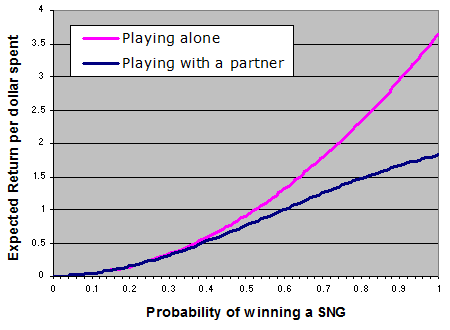
Excel hasn’t rendered the graph very smoothly, but you should get the idea. Unless you’re a particularly awful player, entering the tournament as a team reduces your overall edge. Not only that, but the better you are, the more dramatic the impact is.
For really large values of p, this stands to reason. If you could win every single game without fail, why would you ever play with a partner when you could scoop the prize money by paying just one buy-in instead of two.
However, what’s significant is that even if are an “average” player and win precisely half your games (p=0.5) you are better off going it alone than playing as a team.
It’s not that clear on the graph, but for low values of p, you’re slightly better off playing with a partner. It doesn’t turn you into a winner, but dollar-for-dollar you lose money a little less quickly. (You’ll spew more slowly with two entries in $5 tournament than you do with one entry in a $10).
You can just about see this if you zoom in really close.
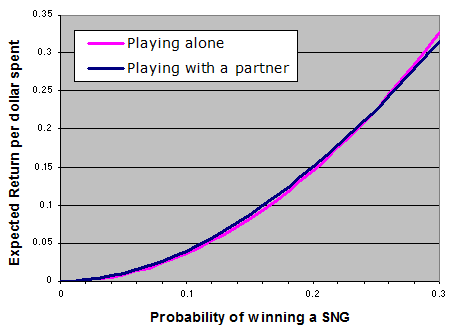
The magic number – the likelihood of winning which is good enough that you’re better off not playing with a partner – is 0.25. If you win 25% of encounters, it makes no difference whether or not you play yourself in round one and win a quarter of the finals, or if you just roll the metaphorical dice and win a quarter of all your games.
Let’s be honest though – if you can’t win one heads up game in four on average, you’d be better off playing roulette than trying to cheat at poker.
EDIT: Already found one error with my graphs. The “magic number” should be 0.5 not 0.25, although this does not affect the conclusion that this is a bad strategy.
I wasn’t aware of this until I just noticed this blog post announcing today is the last day for pre-orders of a new poker book by Ed Miller called “Small Stakes No-Limit Hold’em”.
Immediately all the right ingredients seem to be there for this to be a great title. There’s no doubt that Miller is an excellent writer and seeing his name on a book makes me pay attention.
In particular, “Small Stakes Hold’em” is the definitive text on loose fixed-limit poker games and his contribution to “No Limit Hold’em Theory and Practice”, co-authored with David Sklansky, is no doubt the reason that this is the only Sklansky book that I’ve read that didn’t feel like a chore.
So with all this potential, I clicked through to learn more.
It turns out this title is a self-published e-book.
I’m familiar with the format. Usually it’s used to distribute manuals that tell you how to make a fortune buying televisions on eBay for a couple of quid, or how to earn thousands of dollars every week for filling in surveys. The same way the author does, who generously chooses to share his secret with anyone who has a credit card.
Personally I love the irony of the ones that tell you how to make a career out of selling ebooks.
Miller explains this unusual decision by saying: “E-books are the new wave in poker training”.
I was not aware of this. However a quick Google search did throw up such gems as an online poker “algorithm tracker” that can have a decent guess at what’s going to be dealt next, or an unashamed “cheating system” which claims to show you other players’ hole cards. Both these notions, of course, are preposterous.
So if this product is genuine – and I highly doubt that self-proclaimed Noted Poker Authority Ed Miller would put his name to a scam – what’s so good about making it an e-book?
Does having to read it on-screen on your computer, rather than at your convenience on a train, in bed or on the toilet make the material somehow superior?
I guess you could read it while playing online poker without having to move your head to look between the screen and a book. That’s marginally +eCalories, but those small edges do all add up.
Here’s the kicker though. The book’s tag line is “The affordable poker book”.
Because all those $20-$30 books out there are just a pipedream for anyone who doesn’t already play for nosebleed stakes.
So how much is this one? It’s $39.95.
If you pre-order today.
If you wait until tomorrow, the price will be $99.95.
As I’ve been told that my potty mouth often causes this blog to get blocked when people are reading it at work, I won’t repeat my first reaction – but you can take a pretty good guess.
It really does say $99.95. As if $39.95 wasn’t already taking the wee wee for a book that you have to print yourself if you want to read it on the tube.
Miller’s prevous books, published by Two Plus Two with all the overheads that come with producing and distributing products made out of dead trees, are priced between $24.95 and $29.95. Even the cash cow Harrington on Cash Games only weighs in at $69.90 for both halves of the book.
The Internet has been responsible for helping to drive down the cost of all kinds of stuff. If you can sell it online, it’s cheaper than having a shop. If you can distribute it electronically, it’s cheaper than sticking it in the mail. As a result, those savings are usually passed on to consumers. There are very few exceptions.
I have issues with the price of music at iTunes compared to the cost of CDs, but at least it’s no more expensive and you’re not committed to buying a full album if you only want a few songs. It’s really only Ticketmaster that has such flagrant disrespect for its customers that it charges you a “convenience fee” when they have a monopoly on an event, and then charges you again for the privilege of printing your own tickets.
(Obligatory Ticketbastard rant: I just bought two $15 tickets for The Donnas in Las Vegas next month – yes, really, they rock and you know they do – and the total was $48.50. That’s more than the cost of an extra ticket in fees!).
And then there’s this book.
Miller also doesn’t mention whether Two Plus Two wanted to publish this book. Surely if they did but he’d made the decision to do it independently, this in itself would be a great testamonial to the quality of the work. When you’ve had 150,000 units shipped through this channel in the past, it’s a big leap of faith to go it alone.
If they didn’t want it, why not? And what – apart from the fact that you’ll only have to sell a few dozen copies to make the same amount of money as you would from the royalties from thousands of printed books – makes it worth nearly a hundred dollars?
Unfortunately, I can’t feel anything other than cynicism towards this book’s launch and, regrettably, I will be looking for a free copy on thepokerbay tomorrow.
If I can find it, I’ll send Ed Miller $20 and a link to this post.
EDIT: Publisher Mason Malmuth comments on the price compared what it would have been through 2+2 here:
http://forumserver.twoplustwo.com/showpost.php?p=10550513&postcount=18
The Facebook of poker shirts.
Photo gratuitously borrowed from Wicked Chops Poker, it’s just too good.
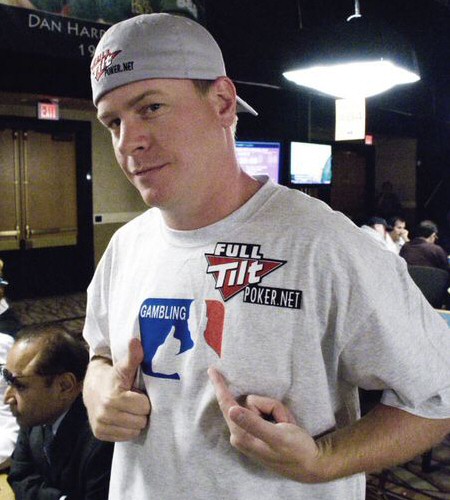
Not content with running into quads virtually every time he appears on High Stakes Poker, Daniel Negreanu is also subjected to a savage beat by Katy Perry in the video to her song "Waking up in Vegas".
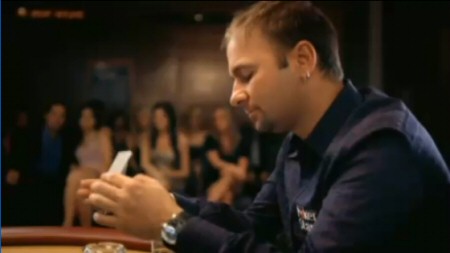
Sure, it’s a music video, but Daniel’s acting is good (as you can see from his sad face, above) so just in case you were wondering whether they’d used real game footage, here’s the first clue that this is fake: the audience of predominantly attractive female poker fans in the background.
We don’t get to see the betting, and the resolution of the cards is pretty crappy in these screen caps, but it looks like Negreanu either ran pocket kings into pocket aces for $17.2m pre-flop, or got it all with quad kings on the flop. Whichever way it happened, Perry’s pocket aces make runner-runner quads to end up as the best hand.
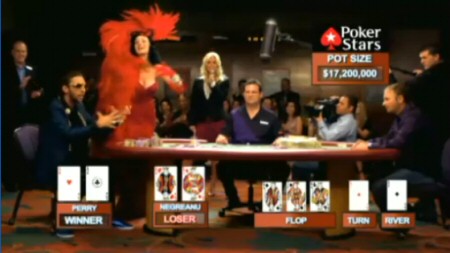
If Poker Stars had a sense of humour, the logo in the corner of the screen would read "lol riverstars". Or they’d put a caption saying "look, it does happen in live poker!"
I really think they missed a trick by playing this one straight, but I guess they want to compete with Bwin’s product placement in that awful Lady Gaga song. All credit to them, they’ve found their own song that’s almost as bad.
Anyway, after the flop, pocket aces are s 900-1 or so underdog… but it can happen. Perry drags down a huge pot in predictably classy fashion.
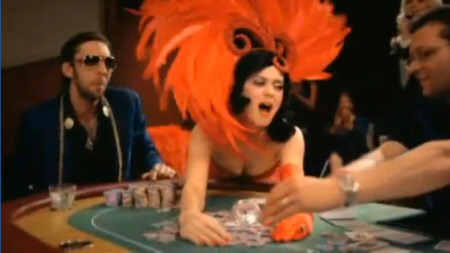
It all works out nicely for Daniel in the end though. Apparently he had enough chips left to stage a dramatic comeback, and taunt her by showing off his bling.
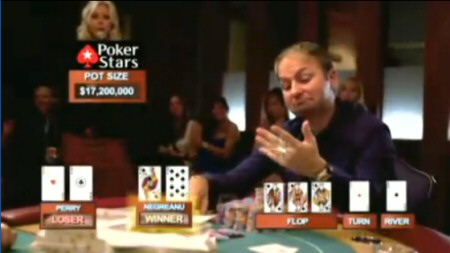
This time he cracks Katy’s pocket aces with king-ten of clubs. At least I think that’s the hand. There’s a reason that poker on TV uses simplified card rank and suit graphics, not little pictures of playing cards.
The flop is all paint and all black. Let’s assume he has a pair of kings and an open-ended straight flush draw – actually a slight favourite over the pair of aces at this point – and that they get the money in on the flop.
The turn brings another ace, but Daniel now has straight against Katy’s three-of-a-kind and is a strong favourite (78%) to win the pot. She needs a jack, queen or king.
The ace of clubs on the river (so that four of a kind is beaten by a royal flush) is unnecessary, but it’s great for television.
Despite this pot being $17.2m – exactly the same size as the one Daniel just lost – Negreanu somehow has enough chips to cover Perry.
Rigged in favour of the big stack, obviously.
We see her throwing her last chip towards him. Like you do. And Katy’s sad face is even better than Daniel’s.
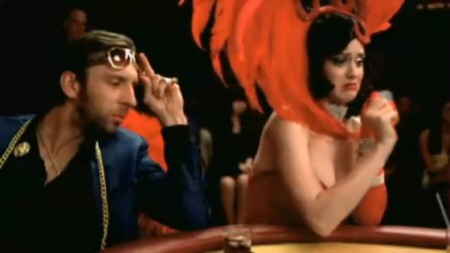
You can see the whole thing here, although the poker scenes do only last about four seconds in total:
http://www.dailymotion.com/video/x94a5w_waking-up-in-vegas_creation
|
|














Comments